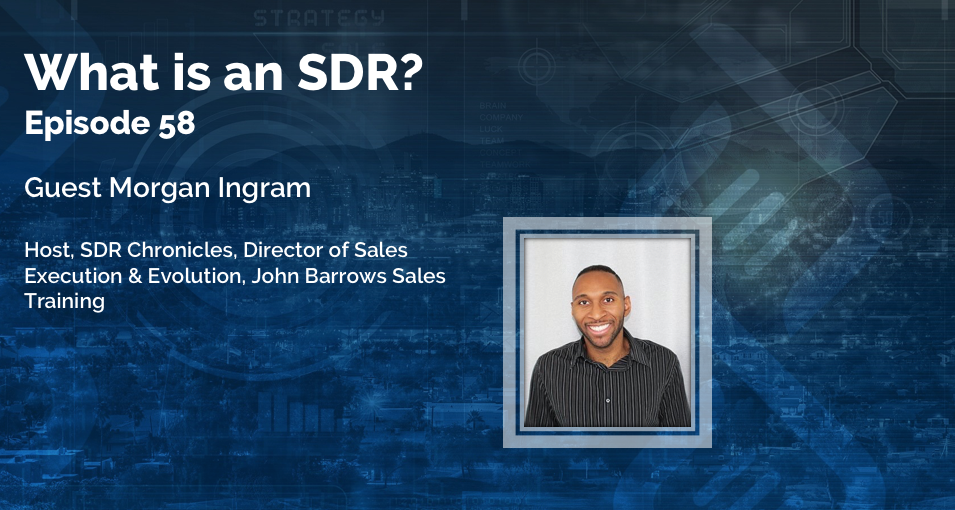Guest – Morgan Ingram, Host of the SDR Chronicles
The Sales Development Representative (SDR) role is another level of specialization within the sales function. Some organizations have adopted this role and successfully integrated the position into their teams, while others struggle with success. Many of the organizations who struggle with success have identified a breakdown in transition process between the SDR and the Account Executive role. Sometimes this hand-off feels forced and is not customer focused.
This week on the Catalyst Sale Podcast, Morgan Ingram, host of the SDR Chronicles joins us to discuss the SDR, the evolution of the role, mindset, and being persistent.
What is an SDR?
SDR stands for Sales Development Representative (SDR) this is the tip of the spear from a sales team perspective. In many organizations, the SDR is the first person the prospect speaks with. The SDR is responsible for gathering initial qualification data from the customer. Who are they, what do they do, what brought them to your website, what are they looking to accomplish, etc.
Once the initial information is gathered, the focus moves to establishing next steps, including scheduling the next call and transitioning the prospect to an Account Executive.
Where Does the Transition Fail
This seems pretty straightforward and should be seamless to the customer/prospect. However, this is where things can get awkward. Think about those times when you are working with customer service, you speak with the first rep, they escalate to the second or the third, and each time you have to repeat your story. Don’t make this your customer’s problem.
Share clear notes with your teammates, set expectations with the customer/prospect, and execute.
Onboarding a new SDR/AE
When onboarding an SDR within your team, or an Account Executive, start with clarifying success criteria and expectations. Each AE/SDR will have their own personality to apply to their role. If you are an SDR and a new AE has joined the team, schedule a 1:1 conversation with the new rep. Gain perspective from them regarding what type of data they would like to see on each customer as part of the hand-off. Find out why the information is important to them, and how they plan to use it.
If you are a new Account Executive in an organization, and the SDR role is part of the structure of the sales team, get to know the team. Ask what has worked in the past when it comes to SDR/AE transitions. Be clear about your expectations, and how the information that is transferred impacts the sales process.
Remember you are a team – teams perform well when roles are defined, communication is clear, expectations are set, and adaptation is allowed to occur based on changing information.
Building Rapport
Building rapport is a skill, a skill that is customer focused, and requires that you take a personal interest in others. Who are they, where do they live, why do they do what they do, etc? This is not about pitching your product, you’ve not earned the right. Take a breath, and learn about what is important to your customer. (Dan Tyre talks about this in a previous post)
Making the transition from Colleague to Manager
The transition from colleague to manager is common. Unfortunately, many people make this transition for the wrong reasons. If your transition is driven by ego, and not based on a foundation of service, you are likely setting yourself up for failure. As you make the transition into leadership, focus on how you can work for others. Leadership is a service, not a mandate or right.
Success
Throughout this Morgan shared a number of concepts that have led to his success. Some of these are mantras we all may want to consider integrating into our approach.
- Consistency Brings Results – If you don’t show up, you can’t show out. You have to be there to be successful. Yes, it’s a grind, but if you don’t show up, you cannot succeed.
- Sweat the details – the little things count
- Expand your view of Data – Monthly data may skew your perception of results, look at the quarterly numbers to help minimize the impact of anomalies.
- Steady mindset – good things will happen, or bad things will happen – know that the one constant is change. Trust your process.
———————-
Thank you
Thank you for rating and reviewing the podcast via iTunes, Google Play, or your favorite podcast platform. Ratings & reviews help others discover the podcast – thank you for helping us get the message out to the community.
Please send listener questions and feedback to hello@catalystsale.com or contact us directly on twitter, facebook or LinkedIn.
Catalyst Sale Service Offerings
Growth Acceleration – Plateau Breakthrough
———————-
Subscribe to the Catalyst Sale Podcast
Catalyst Sale
In every business, in every opportunity, there is someone who can help you navigate the internal challenges and close the deal. There is a Catalyst. We integrate process (Catalyst Sale Process), technology and people, with the purpose of accelerating revenue. Our thoughtful approach minimizes false starts that are common in emerging markets and high-growth environments. We continue to evolve our practice based on customer needs and emerging technology. We care about a thinking process that enables results versus a process that tells people what to do.

